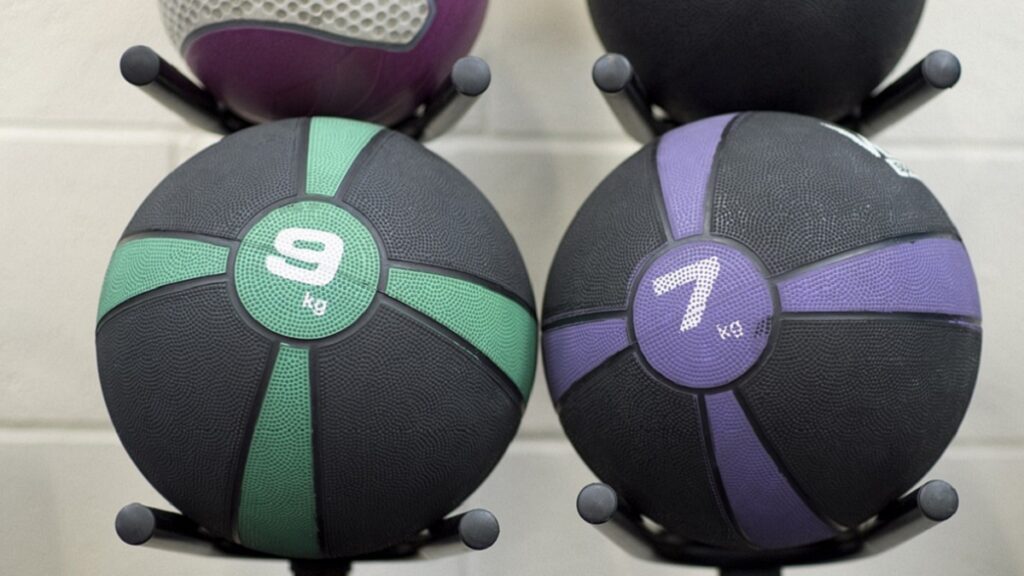The deltoid consists of the rounded muscles of the shoulders found over the sides and top — medial, posterior, and anterior muscles. The deltoid deals with flexion and external rotation of your arms. Hence, exercises (with or without equipment) are essential to strengthen and grow your deltoid muscles. So, which are the deltoid exercises without equipment?
The deltoid exercises you can do without equipment include pike push-ups, handstand push-ups, incline push-ups, shoulder taps, and more. Since the exercises don’t require you to have workout equipment, you have no excuse not to build strength and muscle.
This article compiles a list of non-equipment exercises for your shoulder muscles that can keep the fitness of your deltoids in check. Go through it and diversify your shoulder workout plan.
Deltoid Exercises Without Equipment: What Are the Available Options?
There are many available options for working out your deltoids without equipment, including the following:
- Plank with arm extension
- Tabletop reverse pike
- Handstand push-ups
- Superman (I, Y, & T)
- Regular push-ups
- Archer push-ups
- Incline push-ups
- Hindu push-up
- Shoulder taps
- Pike push-ups
- Plank rockers
- Inverted rows
- Crab walk
Let’s look at each of the above deltoid workouts in detail. Keep reading.
1. Plank with Arm Extension
There are some advanced deltoid exercises without equipment, and Plank with Arm Extension is one of them. The plank variation requires holding a plank as you raise one arm in front. As a result, the exercise strengthens your shoulder and core muscles.
Here are the steps to follow:
- Set your body in a high plank position.
- Lift and straighten your right arm, holding it parallel to the rest of the body.
- Maintain the posture for a set time frame and lower the arm slowly to the starting point.
- Lower your left arm and repeat the exercise with both hands interchangeably.
Tips:
- Keep your body rigid and straight when exercising.
2. Tabletop Reverse Pike
The exercise is one of the deltoid exercises without equipment that strains and targets the shoulders, arms, and core, boosting your body’s stability and strength. Also, it engages your legs and glutes, working out your entire body.
Here are the steps to follow:
- Sit on your workout mat and outstretch your legs.
- Place your arms on the surface, slightly behind and outside your hips (fingers spread wide).
- Press the ground with your palms as you lift your hips from the floor as you inhale. Move until your body is parallel with the ground and the knees are at 90 degrees.
- Ensure that the arms are straight — hands directly under the shoulders. The ankle should be directly under the knees.
- Involve your abs and your hands and heels’ balance.
- Hold the tabletop position for some time and return to the floor as you exhale.
- Repeat the set number of times.
Tip:
- Avoid sagging of your hips or hunching of your shoulders.
3. Handstand Push-ups
The push-up exercise is also called vertical push-up, where you position your body in a handstand. It’s among the advanced deltoid exercises without equipment targeting the arms, shoulders, and core. Hence, you must have a high skill level and upper body strength and only attempt it after adequate training and conditioning.
Here are the steps to follow:
- Take a handstand position against a wall, your hands on the floor surface, and your body straight up.
- Keep your core tight and your glutes squeezed to maintain the handstand position.
- Bend your arms to slowly lower your body towards the ground while your body remains straight.
- Once you get close to the floor, push your body back to the handstand posture, and repeat for the required number of times.
Tips:
- Maintain straight legs and engaged core muscles.
- Ensure your safety and support by having a spotter or working against a wall in your initial stages.
- If the exercise is too challenging, you can start with wall walks.
4. Superman (I, Y, & T)
Superman is on the list of deltoid exercises without equipment whose primary focus is the rotator cuff muscle: infraspinatus, subscapularis, teres minor, and supraspinatus. The muscles are responsible for the mobility and stability of your shoulders.
Here are the steps to follow:
- Lie on the ground on your stomach, in a facedown position.
- Extend your arms in front of your head to form a straight line with your body.
- Maintain a contracted status of your lower back, hamstring, and glutes, as you raise your arms, legs, and chest, co-currently to flex the lower back.
- Bring your arms back to the starting point and raise them up and out, forming a ‘Y’ shape.
- Return them to the starting point again and raise them to the side, forming a ‘T’ shape.
- Repeat to complete the required reps.
Tips:
- Maintaining a neutral position of your head and neck until the end and avoiding shaking movements are essential.
5. Regular Push-Ups
The standard push-ups are the foundational exercises for many deltoid exercises without equipment. They increase your upper body strength, targeting the shoulders, triceps, and chest muscles. Adequate body strength enhances your functional fitness that eases your movements.
Here are the steps to follow:
- Get on the floor on your arms and feet with your face down, arms slightly wider than shoulder-width apart, and legs extended — there should be an even distribution of weight between feet and hands.
- Slightly bend your elbows without locking them out until your chin almost touches the floor. Contract your gluteal and abdominal muscles, exhale when bending your arms, and maintain a flat back.
- Push your body back up to the starting point by straightening your arms. Inhale when pushing up, keep your gluteal and core muscles tight, and maintain a straight back.
- Repeat 8-10 reps of 2-3 sets.
Tips:
- Try an incline position to maintain a straight back if the exercise is too strenuous. On the other hand, if it’s too simple, try a more challenging one by moving each arm 2 inches outwards. The posture works on your deltoids more than the shoulder width position.
6. Archer Push-Up
The high-intensity upper-body exercise is also among the deltoid exercises without equipment. It works several upper-body muscle groups, including the shoulders (anterior deltoids), chest (pectorals), and arms (triceps).
Archer Push-up requires placing your arms wider than the standard push-up position. When lowering your body, you incline towards one hand, transferring most of the weight to it. The other hand remains straight.
Here are the steps to follow:
- Adopt a standard push-up position.
- Keep your core tight and move the upper body to the right side.
- Bend your right elbow as you pull the right side of your chest in the same direction.
- Keep your left arm straight while performing the above movements.
- Your extended left arm should form a straight line with your shoulder.
- Repeat for your choice reps as you switch sides.
Tips:
- Keep your body straight from head to feet.
7. Incline Push-ups
Incline/decline push-ups are a traditional push-up variation targeting the triceps, chest, and shoulders. These deltoid exercises without equipment make an ideal choice if you seek to progress from wall and knee push-ups. Also, they provide an alternative to upside-down and vertical positions.
Here are the steps to follow:
- Standing before a bench, place your hands apart (shoulder-width) on the edge of the bench.
- Extend your legs backward, forming a straight line with the back to adopt a plank position.
- Lower the chest to the bench by slowly bending your arms. Your arms and elbow should remain close to the body.
- Push your body back up, extending your arms to a point where the elbow is slightly bent.
For the decline option, elevate your feet on a bench, lower the chest to the floor, and push it back up.
Tip:
- Exhale when exerting and stand comfortably in front of the bench.
8. Hindu push-ups
Also known as ‘Dhand,’ the deltoid exercises without equipment target the chest, shoulders, triceps, core, and back muscles. It’s a vigorous and challenging exercise, combining yoga and traditional push-ups.
Here are the steps to follow:
- Adopt a ‘V’ shape by placing your feet and hands (shoulder width apart) on the floor.
- Bend your elbows to lower your chest to almost touch the floor.
- Raise your upper body in a scooping motion of your head and arch your lower and upper back.
- Return to the starting point by simply pushing back. You mustn’t reverse back through the scooping-arching path.
- Repeat as required.
Tips:
- Squeeze your shoulder blades and triceps during your upper body raising.
- Exhale and inhale when raising and lowering your upper body, respectively.
- Position your elbows close to the body.
- Keep your core tight.
9. Shoulder Taps
The workout is a full-body exercise, targeting the chest, arms, and shoulders and strengthening core muscles. The variation of deltoid exercises without equipment is challenging for beginners but can be simplified by kneeling.
Here are the steps to follow:
- Get into a standard push-up position with your arms shoulder-width apart.
- Maintain a fully-extended position of your arms, a flat back, and your toes on the floor.
- Raise your right hand and tap the left shoulder.
- Place it back on the floor and tap your right shoulder with the left hand.
- Rotate back and forth for the required reps.
Tips:
- Avoid excessive hip movement and keep the core tight throughout the exercise.
- Maintain an arrow shape at the bottom of your arms, not a “T.”
- Hold your shoulder blades pulled together.
- Keep your head, neck, and spine aligned.
10. Pike Push-ups
Pike Push-Up or shoulder push-up is one of the best and most straightforward deltoid exercises without equipment. It’s a variation of the strength and stability-enhancing push-up exercises for the triceps and shoulders. Also, there’s an elevated version of this workout, where you raise your legs on a bench.
It’s advisable to perform the workout in a more upright posture when your primary focus is your shoulders (deltoids).
Here are the steps to follow:
- Get into a standard push-up position (arms straight and a little outside shoulder-width apart), ensuring your elbows are locked out completely.
- Raise your hips to form an inverted ‘V’ shape.
- Bend your elbows and slowly lower your head’s top towards the ground.
- Pause for a second once your head gets close to the floor.
- Push up your body back to the point where your arms are straight again (the up-side down ‘V’ shape position).
- Repeat for the required reps.
Tips:
- Ensure control throughout the exercise: It’s ‘explosive up and slow down’ and can be dangerous if you slip as you may land on your head.
- Get familiar with hamstring mobility exercises in advance, as their flexibility is a requirement for Pike Push-Ups.
- Don’t engage in elevated Pike Push-Up if you don’t have its mobility.
- Do regular push-up exercises first and proceed to the ‘pikes.’
11. Plank Rockers
The exercise is among the deltoid exercises without equipment that emphasizes more on the shoulders and upper body. Also, it offers all the benefits that come with a strengthened core.
Here are the steps to follow:
- Take a push-up position with your arms straight and your feet hip-apart.
- Push your body towards your heels, bending your legs until your glutes sit on the heels.
- Hinge your hips forward and stretch your arms into a plank.
- Lower onto your elbows, stack your shoulders above your elbows, and keep them relaxed.
- Set your palms flat on the ground and engage your core to take a straight-line posture of your entire body.
- Raise your heels on your toes and push the floor with your toes to ‘rock’ your body forward a little.
- Slide forward slowly for 1-2 inches.
- Once your Abs engage, return to your starting point.
- Work 10 reps of 5 sets in a slow, controlled motion.
Tips:
- Maintain a straight posture of your arms and palms flat on the floor throughout the exercise.
- Go slow and maintain the correct form till the end.
12. Inverted Row
Also known as body weight row, the exercise puts your body in a horizontal position resulting in easy performance. It’s one of the deltoid exercises without equipment that works the shoulder and back muscles from a different angle and enhances the scapular angle.
Here are the steps to follow:
- Position your training bar higher than the length of your arms from the ground.
- Lie straight under the bar and grasp the bar with an overhead grip and your arms slightly wider than shoulder width.
- Pull up your body to the bar as you exhale while your entire body remains straight. Hold for about 2 seconds and squeeze your back muscles.
- Lower your body as you inhale until your shoulders and arms are completely stretched.
- Repeat the required reps.
Tips:
- Keep your butts squeezed, flex your tummy, and keep the entire body stiff throughout the workout.
- Lower your body until your arms are completely stretched, and raise it until the chest touches the bar.
13. Crab Walk
The bodyweight exercise is among the excellent deltoid exercises without equipment, focusing on the upper arms, legs, shoulders, and core. It’s ideal for toning, targeting all muscle groups effectively to strengthen them. The exercise is excellent for your whole body when you have little time or don’t have workout equipment.
Here are the steps to follow:
- Sit on the floor and place your hands and feet flat on the floor, with your face up.
- Lift your body so your arms are straight below your shoulders and feet below your knees.
- Raise your butt by tightening your gluteal muscles and keep your core up.
- Walk on your hands and feet by moving your hands and then feet: Right hand and left leg, then left hand and right leg interchangeably.
Tips:
- Don’t move your hand more than 8 inches at a time to avoid excessive shoulder strain.
- Avoid moving your upper body at high speed to prevent shoulder injuries.
- Keep your movements under control.
FAQ
Are Deltoids Easy to Build?
No, deltoids aren’t easy to build. Delts are an extremely stubborn muscle group for many people to develop. That happens when targeting the side deltoids. However, you may find it not or less challenging when working your front delts.
Can Delts Be Trained Every Day?
No, you can’t train your delts every day. Typically, you should have 8-12 sets per week. The sets can be split into 3-4 sets, 2-3 times per week, across the training. Even so, you can train your shoulders frequently if you aren’t straining them excessively.
Which Push-Up Is Best for Deltoids?
The best push-up for deltoids is Handstand Push-Up. The exercise yields incredible strength to the upper body and builds the anterior delts, primarily the front shoulder. However, this push-up variation is the hardest to perform.
Do Deltoids Take Long to Develop?
Yes, deltoids take a long time to develop. It takes a longer time to develop shoulder strength than lower body strength. Thus, you must be patient enough to see your desired results. For instance, some training programs may take 12-16 weeks.
Conclusion
Our list of deltoid exercises without equipment has something for everyone: From beginners to intermediate and advanced trainers; you have a way of handling your delt fitness. The exercises are great for enhancing shoulder strength and muscle mass building. Also, the workouts improve stability and overall fitness.
Hence, you have no excuse to neglect your deltoids wellness due to a lack of training equipment or sufficient time for complex exercises. The workouts are highly recommended when you seek wide shoulder building and strength.
Also, these bodyweight shoulder exercises are easy to perform, requiring no technical details. Consider some for your workout routine and enjoy the results.



